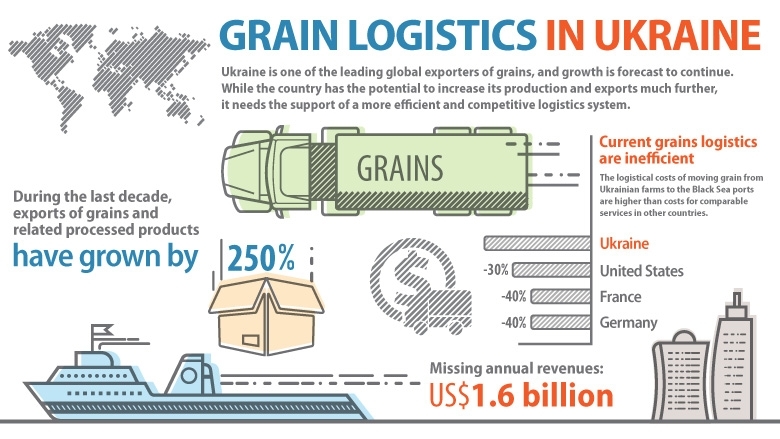Overview
Ukraine is today one of the leading global exporters of grains such as corn (maize), wheat, barley and sunflower seeds. During the past decade alone, exports of grains and related processed products grew by a staggering 250% and, going forward, Ukraine has the potential to continue increasing its production and exports even further.
To realize its full potential, however, Ukraine’s grain sector needs the support of an efficient and competitive logistics system – which is currently not the case. For instance, the logistics costs of moving grain from Ukrainian farms to Black Sea ports are approximately 40% higher than costs for comparable services in France and Germany, and about 30% higher than costs in the United States.
Logistics costs generally include costs related to transportation, warehousing, storage, cleaning, drying, handling, document processing, duties, packaging, security, and any fees, tariffs and duties associated with the export of grain.
As a result of higher logistics costs, farmers in Ukraine receive lower shares of world market prices – they shoulder the costs of inefficiencies in logistics that, according to various estimates, result in foregone revenues of between $600 million and $1,600 million each year, or 20-50% of the current volume of bank loans to agriculture. This has significantly negative implications for investment and competitiveness in the sector.
Research points to five main reasons behind the current high costs of logistics: 1) a lack of regulatory clarity and sub-optimal management of public assets that create barriers to private investments, 2) underutilization of river transport, 3) underinvestment in rail transport, 4) inadequate storage capacity, and 5) excessive use of road transport.
Grain logistics in Ukraine face a dual challenge in the form of present-day high costs and insufficient capacity to cope with future growth. High costs are diminishing the competitiveness of Ukraine’s grain production and reducing the revenue flows to farmers, with negative impacts on sector investment – something which is dearly needed to raise productivity.
The limited capacity of logistics, on the other hand, is projected to become an important bottleneck to future growth – unless it is addressed in time. This dual challenge calls for a holistic investment and reform agenda.
Above all, Ukraine’s government needs to focus on creating a regulatory environment in which the private sector is eager to invest, eventually leading to progressively lowered logistics costs and increased revenue for farmers.
Most importantly, the regulatory changes should be coordinated. For example, a stricter enforcement of axle load limitations by itself might only further increase the costs of logistics, rather than lower them. But, if done in parallel with reforms in rail and river transport, logistics costs can be effectively reduced.
Download the full report: Shifting into Higher Gear: Recommendations for Improved Grain Logistics in Ukraine (PDF)

